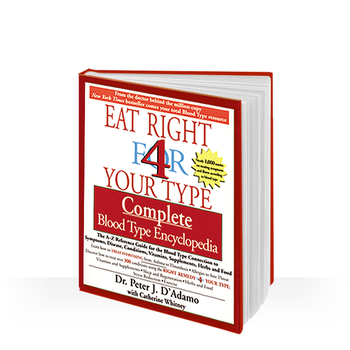A wikipedia of Dr. D'Adamo's research
C O N T E N T SSee Also
DescriptionIn molecular biology, two nucleotides on opposite complementary DNA or RNA strands that are connected via hydrogen bonds are called a base pair (often abbreviated bp). In DNA, adenine (A) forms a base pair with thymine (T), as does guanine (G) with cytosine (C). In RNA, thymine is replaced by uracil (U). ExamplesAs DNA is usually double-stranded, the number of base pairs given for a particular DNA strand is the number of nucleotides in one of the strands. Thus, the following examples of base-paired nucleotide sequence are said to be six base-pairs long: A base-paired DNA sequence: ATCGAT TAGCTA The corresponding base-paired RNA sequence: AUCGAU UAGCUA
Length unitThe following abbreviations are commonly used to describe the length of a DNA/RNA molecule:
In case of single stranded DNA/RNA we talk about nucleotides, abbreviated nt (or knt, Mnt, Gnt), rather than base pairs, as they are not paired. Hydrogen bonding and stabilityHydrogen bonding is the chemical mechanism that underlies the base-pairing rules described above. Appropriate geometrical correspondence of hydrogen bond donors and acceptors allows only the "right" pairs to form stably. The GC base pair has three hydrogen bonds, whereas the AT base pair has only two; as a consequence, the GC pair is more stable. The larger nucleic acids, adenine and guanine, are members of a class of doubly-ringed chemical structures called purines; the smaller nucleic acids, cytosine and thymine (and uracil), are members of a class of singly-ringed chemical structures called pyrimidines. Purines are only complementary with pyrimidines: pyrimidine-pyrimidine pairings are energetically unfavourable because the molecules are too far apart for hydrogen bonding to be established; purine-purine pairings are energetically unfavourable because the molecules are too close, leading to electrostatic repulsion. The only other possible pairings are GT and AC; these pairings are mismatches because the pattern of hydrogen donors and acceptors do not correspond. (It should be noted that the GU pairing, with two hydrogen bonds, does occur fairly often in RNA but rarely in DNA.) Paired DNA and RNA molecules are comparatively stable at room temperature but the two nucleotide strands will separate above a melting point that is determined by the length of the molecules, the extent of mispairing (if any), and the GC content. Higher GC content results in higher melting temperatures; it is therefore unsurprising that the genomes of extremophile organisms such as Thermus thermophilus are particularly GC-rich. Conversely, regions of a genome that need to separate frequently - for example, the promoter regions for often-transcribed genes - are comparatively GC-poor (for example, see TATA box). GC content and melting temperature must also be taken into account when designing primers for PCR reactions. Base stackingBase stacking interactions between the pi orbitals of the bases' aromatic rings also contribute to stability, and again GC stacking interactions with adjacent bases tend to be more favorable. (Note, though, that a GC stacking interaction with the next base pair is geometrically different from a CG interaction.) Base stacking effects are especially important in the secondary structure of RNA; for example, RNA stem-loop structures are stabilized by base stacking in the loop region. Base analogs and intercalatorsChemical analogs of nucleotides can take the place of proper nucleotides and establish non-canonical base-pairing, leading to errors (mostly point mutations) in DNA replication and DNA transcription. One common mutagenic base analog is 5-bromouracil, which resembled thymine but can base-pair to guanine in its enol form. Other chemicals, known as DNA intercalators, fit into the gap between adjacent bases on a single strand and induce frameshift mutations by "masquerading" as a base, causing the DNA replication machinery to skip or insert additional nucleotides at the intercalated site. Most intercalators are large polyaromatic compounds and are known or suspected carcinogens. Examples include ethidium bromide and acridine. LinksAttribution
|
COMPLETE BLOOD TYPE ENCYCLOPEDIA
The Complete Blood Type Encyclopedia is the essential desk reference for Dr. D'Adamo's work. This is the first book to draw on the thousands of medical studies proving the connection between blood type and disease. Click to learn more
Click the Play button to hear to Dr. Peter J. D'Adamo discuss .
|
The statements made on our websites have not been evaluated by the FDA (U.S. Food & Drug Administration).
Our products and services are not intended to diagnose, cure or prevent any disease. If a condition persists, please contact your physician.
Copyright © 1996-2024, Hoop-A-Joop, LLC, Inc. All Rights Reserved. Privacy Policy | Log In
